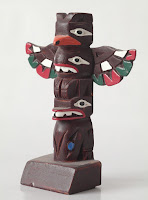Notes on Model Poles History
Model totem poles like these have suffered from the pejorative label, “tourist art,” and been written off
as culturally vacuous and ethnographically irrelevant, but contextualized, model totem poles are
compelling, aesthetic testimonials of Native identity and cultural endurance and reveal much about the
intercultural encounter between Natives, settler societies, and non-Natives.
Originating in the Northwest coast, the tall, freestanding cedar totem pole, the precursor to the model
pole, has historically served and remains a monument to convey family history, and status. Totem poles
traditionally include heraldic crests and figures of ancestors, express lineage identity, memorialize
deceased chiefs, mark special claims to territory and hereditary tangible and nontangible property, tell
stories, and commemorate significant events.
Totem poles in the form of columns and carved house posts existed long before European and
Euroamerican contact with Northwest Coast peoples, but the world’s longstanding and enduring
infatuation with them commenced with the arrival of explorers to the area in the late 18thcentury.
Captain James Cook, sailing on the Resolution from England to Vancouver Island in 1778, was the first
non-Native to record a Northwest Coast column, which he saw in the interior of Chief Maquinna’s house
at the village of Yuquot. Other explorers, artists, and botanists documented carved house posts in the
years that followed. As Europeans and Americans were increasingly drawn to the Northwest Coast by the
bourgeoning fur trade, steel tools became increasingly available, wealth, for some Natives involved in
the trade, increased, displays of wealth were enhanced, and the totem pole flourished. By the 1870s,
nearly a century later, the totem pole was increasingly coveted by foreigners as natural history
museums and international fairs began sponsoring collecting expeditions to obtain totem poles, the
greatest ethnographic prize of the day, to compliment displays of other large scale things – Egyptian and
pre-Columbian stelae and whale and dinosaur skeletons.
The naissance of the steamship industry in the late 19th century and passengers’ demand for small,
portable curios generated the market for the model totem pole and did the most to embed the iconic
image in the American psyche. In 1884, steamships began coming to Alaska and tourism companies
appropriated the totem pole, transforming it into an iconic promotional tool and image for pamphlets
and brochures. Steamships sailed to Native villages, offering passengers views of poles in situ. To
facilitate tourists’ access some poles were relocated along steamer routes and to urban parks where
they were frequently photographed for postcards. Passengers disembarking at ports were eager to bring
home remembrances of Alaska and in response to the new market for souvenirs Native artists of
southeastern Alaska and western British Columbia began carving small totem poles for sale and trade.
The models were sold directly to tourists by Natives at wharves and were later sold to curios stores at
ports of call including in Juneau, Wrangell, Seattle, and Vancouver. Mail order catalogues were
developed by retailers to sell model poles to people who could not make the trip to the Pacific
Northwest.
By the early twentieth century, model poles became the most popular souvenir bought by
Northwest Coast tourists.
Despite their popular appeal, collectors, curators, and anthropologists have often dismissed model
totem poles as “tourist art,” disparaging their potential aesthetic and cultural value and capacity to
reveal important information about the Native carvers who made them and the non-Native consumers
who purchased them. Some models were carved with less care than others, but many early model
totems have imagery similar to that of full-scale poles, and reflect the artistic sophistication of their
carvers and specific local, regional, and tribal carving traditions. Many tourists buying models had little
understanding of those traditions and projected onto the carvings their own remembrances,
stereotypical ideas about Alaska, and generalized views of Natives.
Yet the commercial value of model
totem poles and their marketability made it possible for Native peoples to continue traditional carving
and explore artistic conventions at a time when missionary and government pressures to assimilate
prevented them from carving full-scale totem poles. In this sense, model totem poles were artistic
expressions of cultural resilience and endurance despite and in some ways because of their legacies as
commodities.
copyright -The Sheldon Jackson Museum - State of Alaska Dept. of Education
From the Author's Collection
Resin Thunderbird Style
Other Decorative Artefacts
Hand Carved Wooden Items
Hand Carved Wooden Thunderbirds
Below - Size and scale reference shots














































































































































































































































































